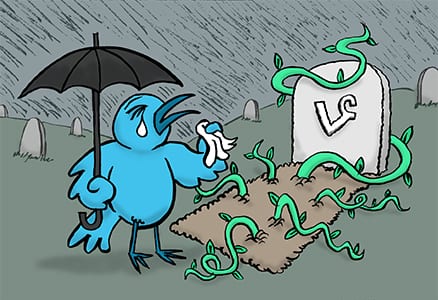 Twitter’s move to shutter its Vine service is a big piece of social media news; but not for the reason you might think. Whilst eulogies have flooded in from around the web, celebrating the innovative and genuinely different types of content that Vine introduced to the online world, even the most rose-tinted of obituaries have openly admitted that for those paying close attention, the writing has been on the wall for some time.
Twitter’s move to shutter its Vine service is a big piece of social media news; but not for the reason you might think. Whilst eulogies have flooded in from around the web, celebrating the innovative and genuinely different types of content that Vine introduced to the online world, even the most rose-tinted of obituaries have openly admitted that for those paying close attention, the writing has been on the wall for some time.
The decline of Vine is not the big piece of news, even with Twitter callously and suddenly swinging the executioners axe by releasing the news just one hour before Apple’s big MacBook Keynote event—a classic news burying tactic.
If we are honest, Vine’s untimely death, just four years after Twitter stumped up $30million to purchase it before it had even launched to the public, will barely cause a ripple of discomfort for communicators and brands, as it never truly caught on as a B2C social media platform. It will also barely register on the consciousness of most consumers. Instagram video, Boomerangs and Stories, along with Snapchat, have long since become the short form video platforms of choice. And, it will not even really impact content creators and influencers, most of whom have already either migrated or diversified to other platforms (and particularly YouTube, where their content can be easily monetised).
The big news here is what it reveals about Twitter. Twitter has been struggling for years to achieve user growth and establish profitability. To put this into perspective, Facebook made over $3.5billion in profit in 2015, whilst Twitter, made a $520million loss. Hidden alongside the Vine announcement were the layoffs of nine percent of its global staff; and that’s following an eight percent cull just twelve months ago. Whilst retaining a confident and calm demeanour on the surface of their financial struggles, those paying attention have regularly seen the panicked kicking of legs beneath the boardroom table over the last eighteen months. Users have seen constant changes; a new timeline algorithm, changes to tweet character limits, the launch of Periscope and Twitter Moments, constant back-end functionality tweaks and an almost countless number of new advertising executions and solutions for communicators and brands.
Unfortunately, despite this expulsion of energy, the situation remains largely the same. Now, with the shuttering of Vine, Twitter has finally had to make a change that cannot be spun as a positive, functional and forward thinking, but one that is fuelled purely by financial necessity. This is quite significant, and with their cover now blown in 2017, I would expect to see Twitter be bolder and braver in how it looks to re-shape its product, and to stop tiptoeing around the conservative status quo appeals of its existing user base. Expect to see the end of gentle tinkering around the edges and, potentially, some big, significant changes to how the service works, as attempts to turn around ailing fortunes get serious.
To be clear, Twitter is not dead in the water. There are hundreds of millions of dedicated users. The real-time directness of communication at its core is still incredibly powerful, and something that no other social platform can get close to; although Facebook has certainly started to chip away at it through its own Trending Stories and Live Video efforts. But the real threat for Twitter is not really other platforms, but its own lack of appeal and relevance to a general, broader audience and its inability to justify a bigger part of the ever growing pot of a brand’s online advertising spend. Twitter can (and surely will) continue to chop and change its product, its rules and its auxiliary services, but the underlying business problem of growth and profitability is one that will have no quick fix.


